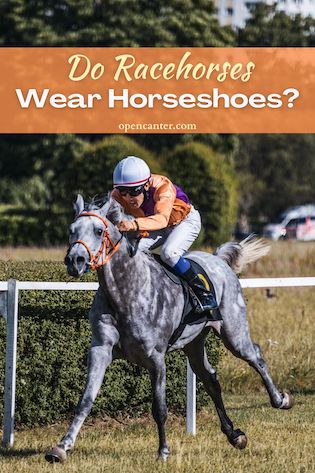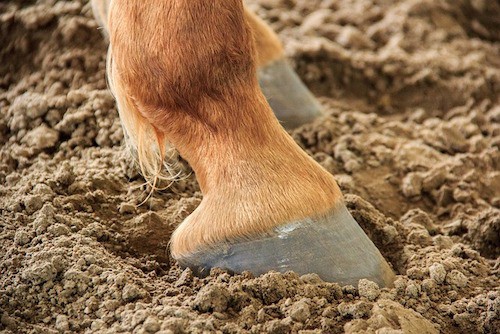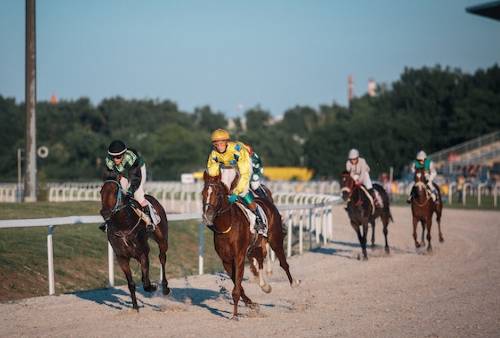Affiliate Disclaimer
As an Amazon Associate I earn from qualifying purchases. It helps me keep the website going. Thank you for your support.
Horseshoes are a piece of specially shaped material fitted to a horse’s hoof. The use of shoes is important to the everyday ridden horse – but do racehorses wear shoes? Their goal is to be the fastest horse on race day; do they wear shoes to help their performance?
Nearly all racehorses wear shoes, but they are not a compulsory item in the racing industry. Horses are allowed to race without wearing shoes. However, most racehorses do wear shoes to help protect the hoof during training and racing. The use of horseshoes can also improve their performance on race day.
The career of a racehorse depends on its talent or speed, fitness, and lack of injury. Read on to learn more about how using horseshoes can play an important role in the life of a racehorse.

Why Do Racehorses Wear Shoes?
The primary purpose of horseshoes is to protect and support the hoof. Like human shoes, they are fitted to each individual hoof by a farrier.
If fitted correctly, they can help to reduce pressure or bruising on the sole of the hoof. The sole is sensitive, and injury can be caused by stones or work on hard ground.
Shoes also protect horses’ hooves from wearing away faster than they can grow. This is important due to the amount of work racehorses do to become fit.
Racehorse trainers have a training program for each horse. It is not uncommon for a racehorse to be worked four to five days a week. This can include fitness work in dry sand or on a grass track. Some trainers take their horses swimming at the beach or in a horse pool.
Wet and dry surfaces can cause changes in the hoof as it soaks in water or dries out. Horses’ hooves are made from the same protein as human fingernails, called keratin.
When we get out of the shower, our nails are more flexible than they were before we got into the shower. The same happens to horses’ hooves as they move between wet and dry areas. And a lot of thoroughbreds’ feet are sensitive to moisture (source). Horseshoes help reduce excess flexibility when the hoof is wet and prevent cracking when the hoof is dry.

Horseshoes can also help protect the hoof from the effects of hard ground. The horseshoe provides space between the ground and the sole to reduce the force felt by the horse. This is especially important when working in stony environments, to prevent bruises to the sole.
Racehorses wear shoes to also benefit from added traction. This helps them maintain speed when racing in wet or slippery conditions.
Does Wearing Shoes Help Racehorses Run Faster?
There is no direct link between horseshoes and increased speed. However, shoes help keep the horse pain-free, which results in better performance.
If a racehorse is in pain, it will not run as fast as it possibly could. Horseshoes help to reduce shock to the legs and hooves during racing, reducing jarring.
Horseshoes also provide added traction, which can prevent slipping and increase speed when compared to horses without shoes.
Do Only Racehorses Wear Shoes?
No – all breeds of horses can wear shoes. However, not every horse will wear shoes. Horses participating in more active disciplines are more likely to wear shoes. Those who are retired or who are very young are less likely to wear shoes. You can read more about what horses did before shoes here.
The decision to fit shoes to a horse depends on how much work the horse does. Racehorses wear shoes because they do a lot of high-intensity work, causing lots of wear to the hoof.
Other activities considered high-intensity include jumping, dressage, reining, or endurance riding. These horses also often wear shoes to protect their hooves.
If a horse does little to no work, such as retired or young horses, their hooves experience much less wear.
Other things to consider include if the horse has hard feet, any conformational or movement faults or any other health issues.
What Kind of Shoes are They?
Most riding horses will wear horseshoes made of steel. However, most racehorses wear shoes that are made of aluminum.
This is because aluminum is a lighter material than steel. The aim of a racehorse is to be the first across the finish line, so any reduction in weight helps.
These aluminum shoes are often referred to as racing plates. This is because they are specially designed for traction and are lighter in weight.
Racing plates usually also have smaller nail holes, to allow for the use of a smaller nail. Thoroughbreds commonly have a thinner hoof wall than other breeds, so there is less room for nails to hold the shoe on.
Horseshoes designed for racehorses may also have a toe grab. This is an addition to the shoe and works like a cleat. It gives added traction to the horse resulting in greater speed and stability.
The toe grab is a small piece of metal, attached to the horseshoe under the toe of the hoof.
The length of the toe grab depends on the surface the horse is racing on. The wetter or softer the surface, the longer the toe grab will be. However, if the toe grab is too long, it can put extra strain on the horse’s tendons.

Some racehorses wear shoes that are specially designed to correct posture or movement. These are called corrective shoes.
What are corrective shoes?
Corrective shoes are customized to suit each individual horse. They are often used to fix an issue in the horse’s movement or hoof before it causes an injury. These shoes can also be used to aid recovery from injury by helping the horse to move correctly. Their concept is like humans using specially shaped inserts in their shoes.
Corrective shoes are not limited to racehorses. Horses from all disciplines and breeds can wear corrective shoes. Their use will depend on the specific requirements of the horse.
Other types of shoes racehorses might wear include plastic shoes or glue-on shoes. Some racehorses have very brittle hooves, and nails break the hoof wall. These horses often benefit from glue-on shoes, which may be made from steel or plastic.
Sometimes a resin-like material is used to coat the hoof or fill in gaps where the hoof wall is missing. This resin sets hard and is designed to act as part of the hoof wall. Then the shoe can be fitted, with some nails going into the hoof wall and others into the resin. Once the hoof wall regrows, there is no longer a need to use the resin.
Corrective shoes are designed to help fix a particular issue. Usually, once that issue has been resolved, the horse can return to wearing normal shoes.
Do Racehorses Wear Shoes All The Time, or Only When Racing?
While they are in training or actively racing, the racehorse will always wear shoes. The increased work will mean more protection for the hoof is needed.
However, racehorses are often turned out for a rest during the off-season. During this time, they are not worked at all but spend most of their time in a paddock. There is less wear on the hoof, and therefore less need for shoes.
Some thoroughbreds have particularly sensitive feet, and if left unshod, will be lame. These horses will commonly wear shoes for their entire life, regardless of activity level.
Final Thoughts
While not all racehorses wear shoes, most of them do. Horseshoes help to support the horse while racing and training and to protect their hooves. They can also help prevent injury, meaning the horse can have a longer racing career. Additionally, they can enhance speed, helping the horse to win more races.




